Charles E W Bean, Diaries, AWM38 3DRL 606/248/1 - 1917 - 1931 - Part 14
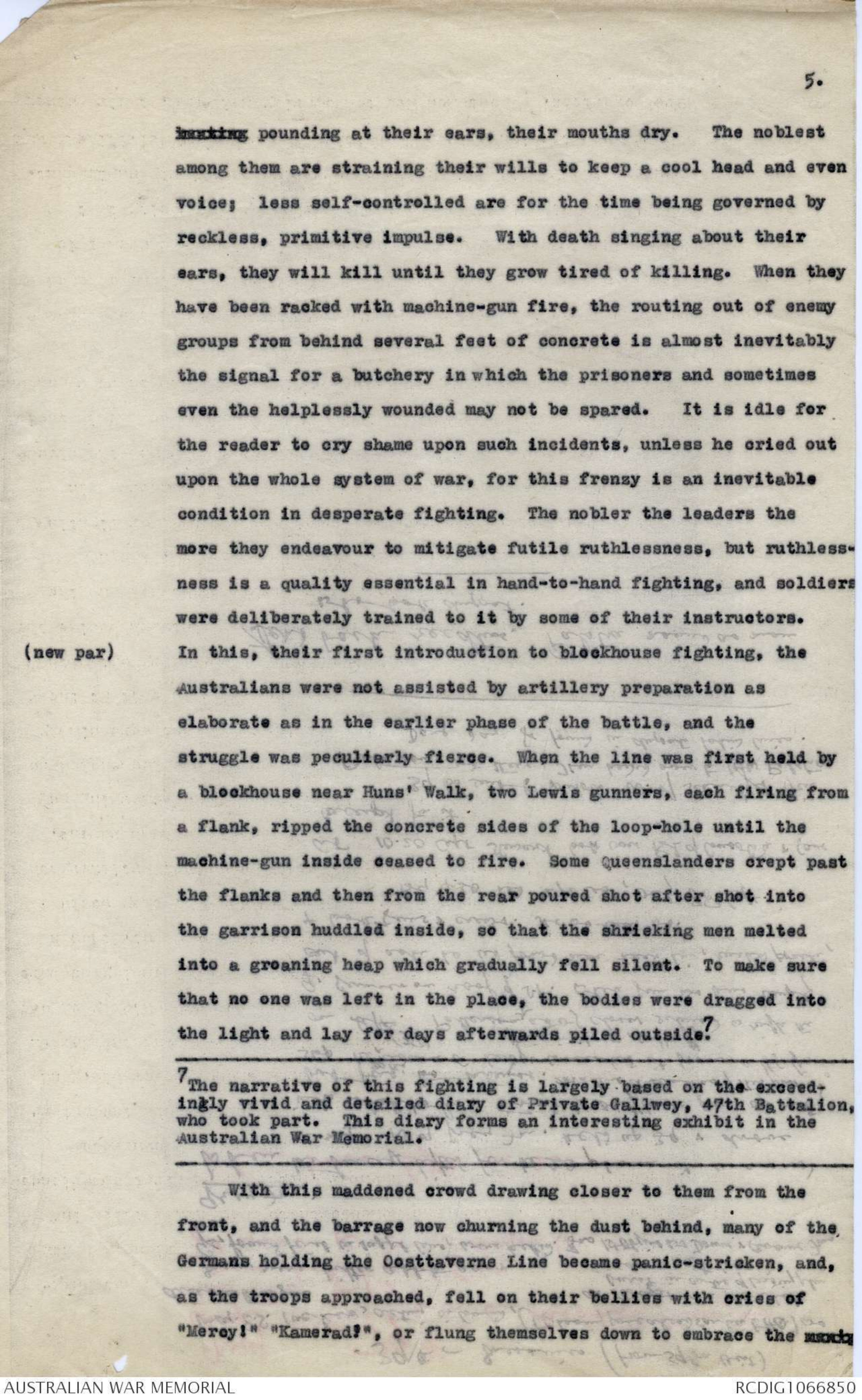
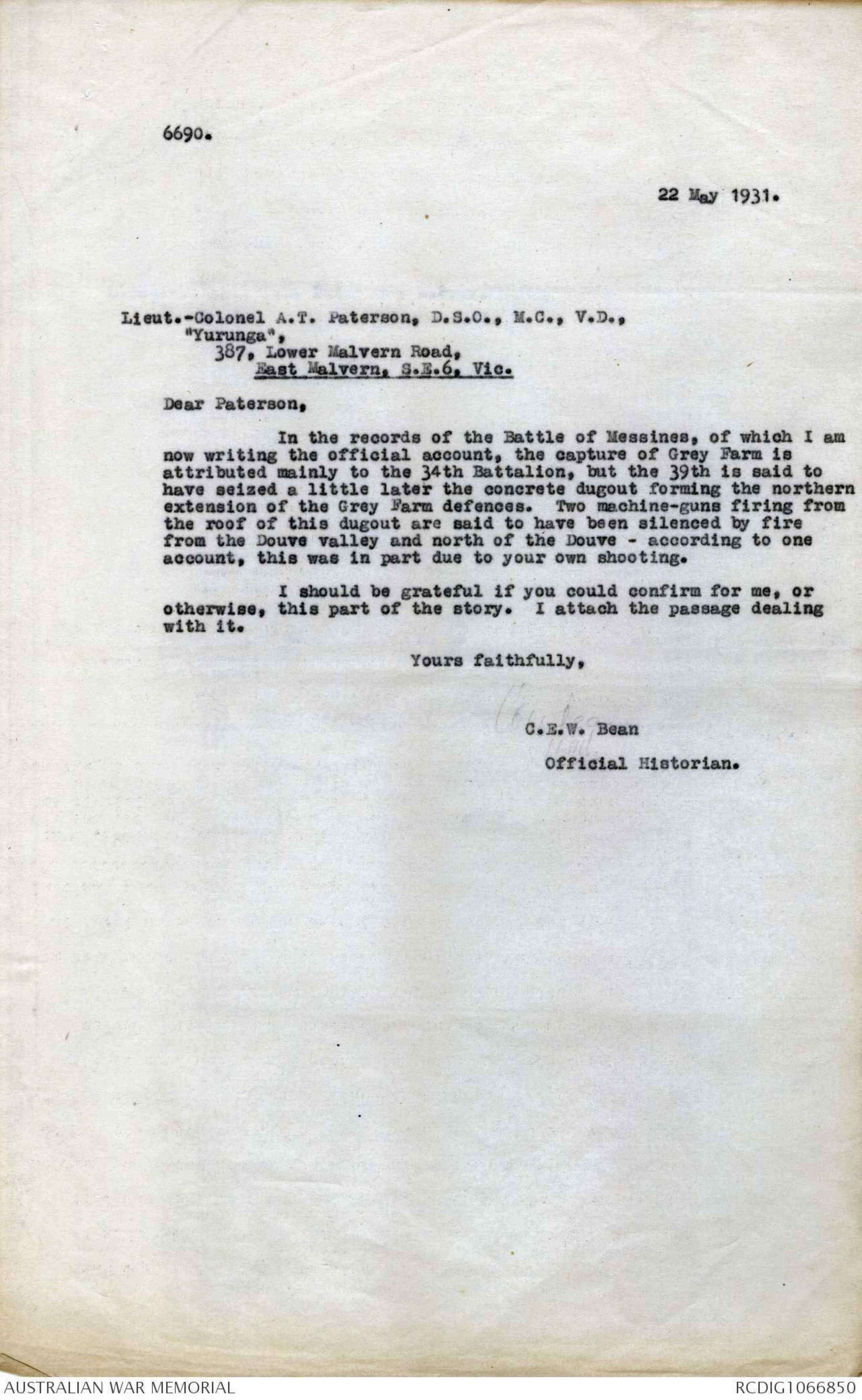
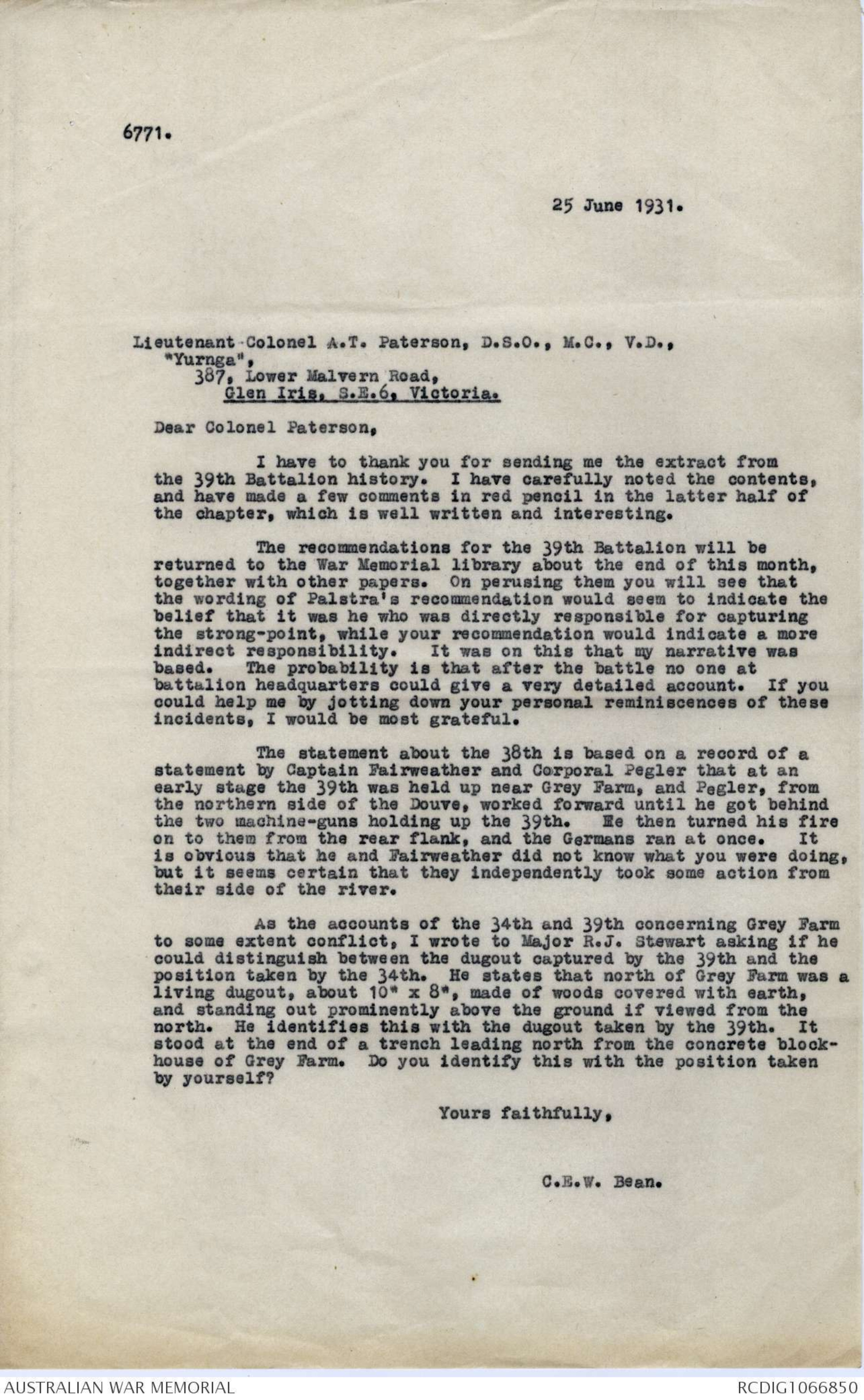
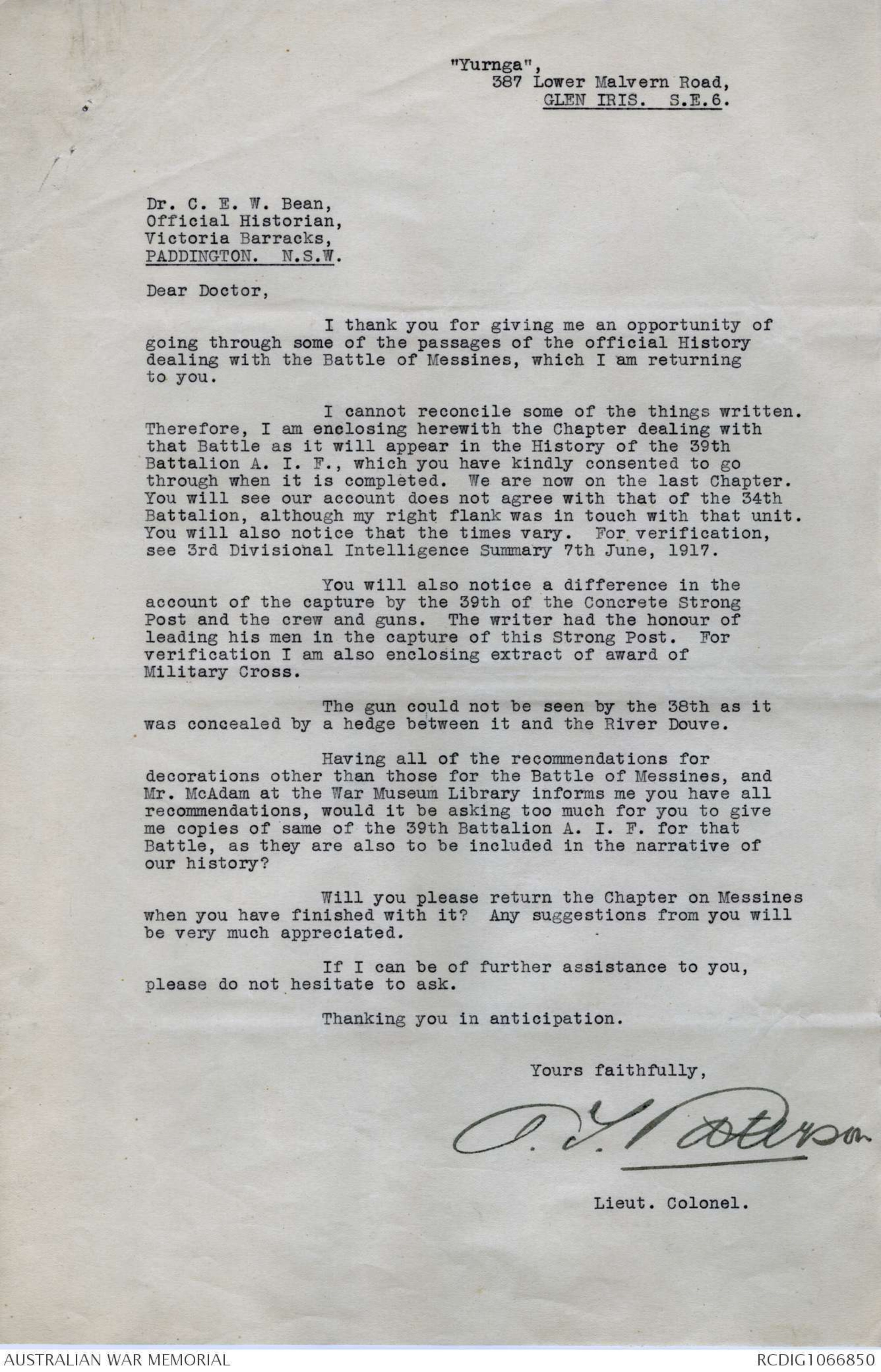
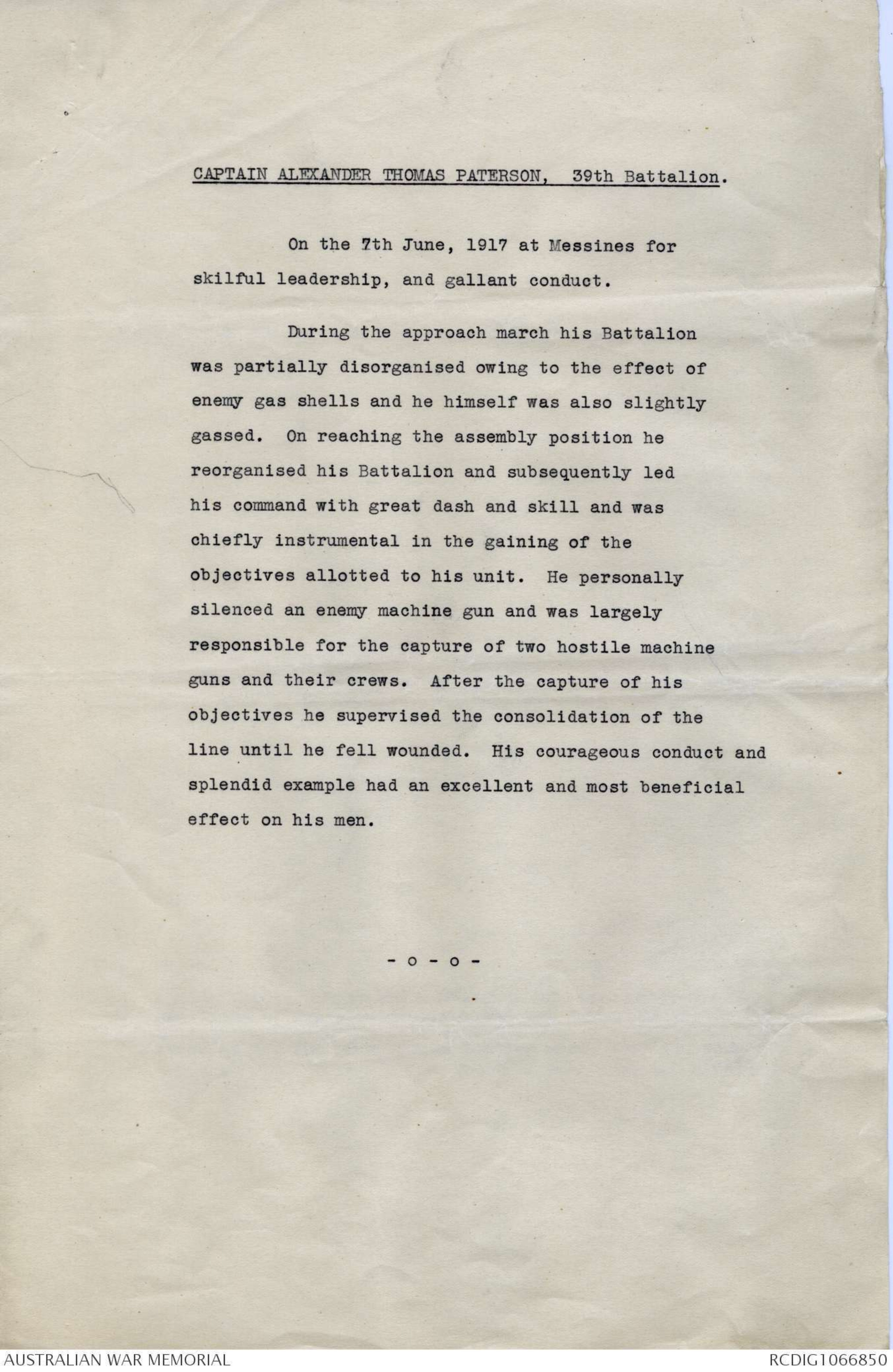

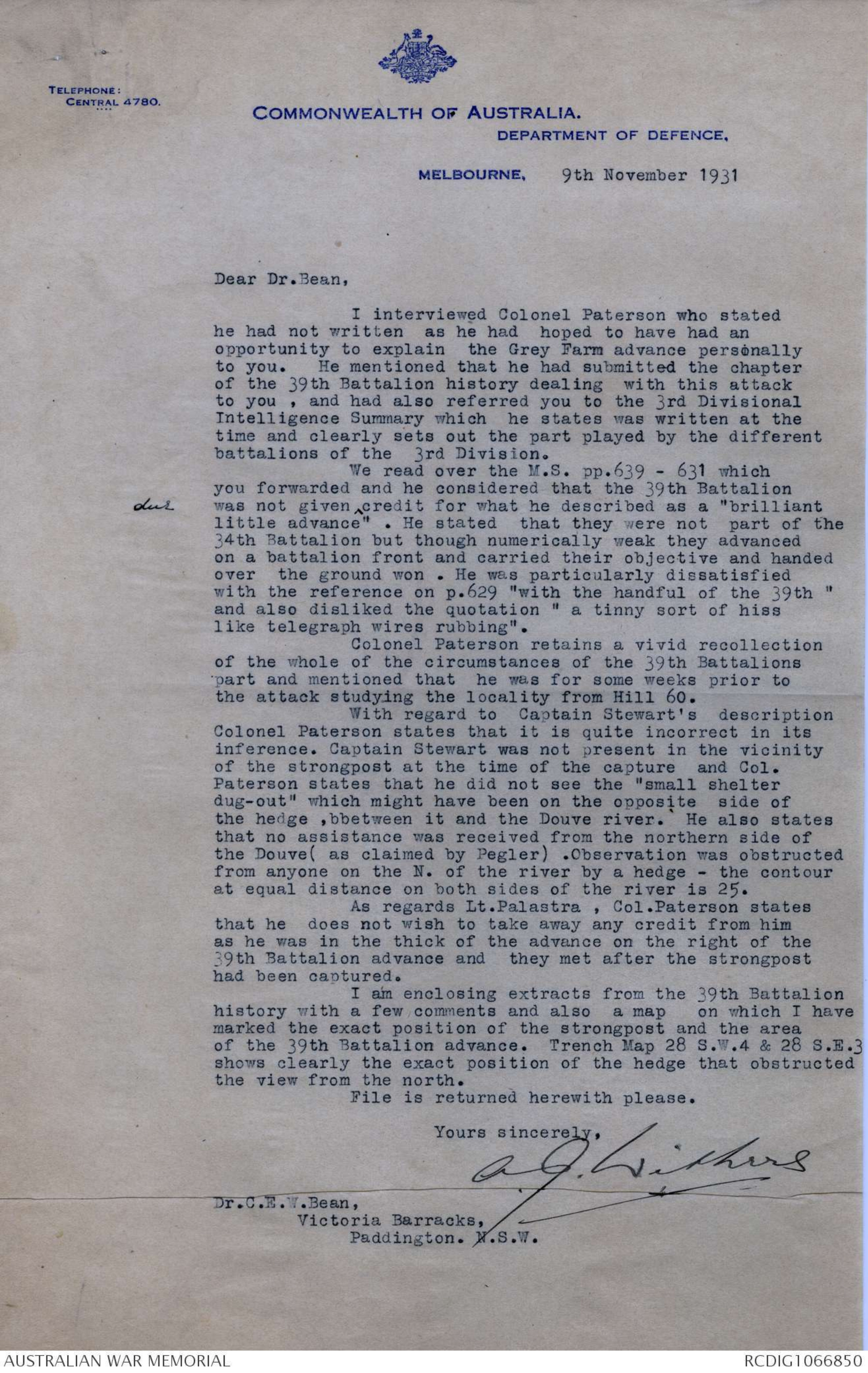

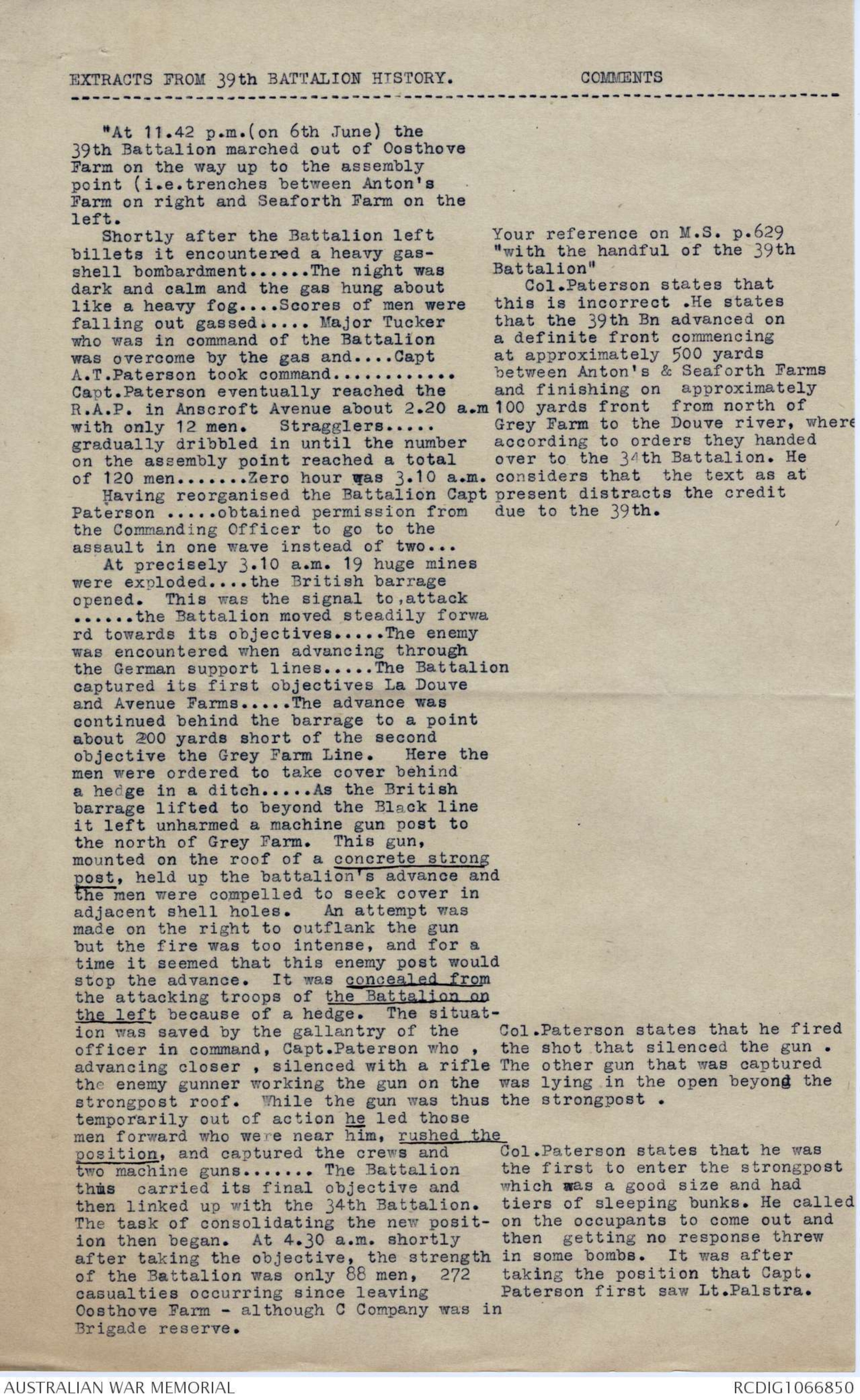
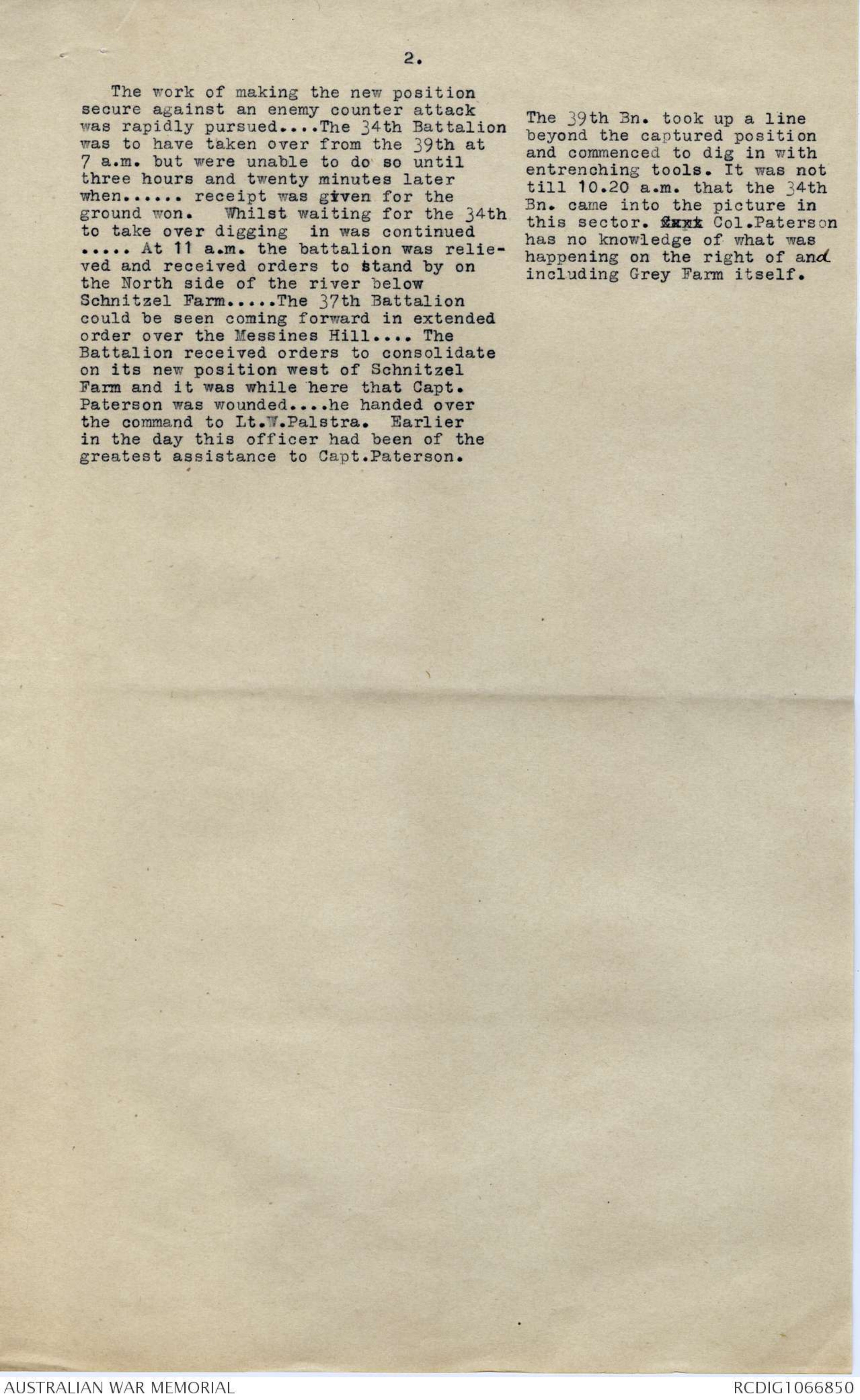
5.beating pounding at their ears, their mouths dry. The noblest
among them are straining their wills to keep a cool head and even
voice; less self-controlled are for the time being governed by
reckless, primitive impulse. With death singing about their
ears, they will kill until they grow tired of killing. When they
have been racked with machine-gun fire, the routing out of enemy
groups from behind several feet of concrete is almost inevitably
the signal for a butchery in which the prisoners and sometimes
even the helplessly wounded may not be spared. It is idle for
the reader to cry shame upon such incidents, unless he cried out
upon the whole system of war, for this frenzy is an invitable
condition in desperate fighting. The nobler the leaders the
more they endeavour to mitigate futile ruthlessness, but ruthlessness
is a quality essential in hand-to-hand fighting, and soldiers
were deliberately trained to it by some of their instructors.
[*(new par)*] In this, their first introduction to blockhouse fighting, the
Australians were not assisted by artillery preparation as
elaborate as in the earlier phase of the battle, and the
struggle was peculiarly fierce. When the line was first held by
a blockhouse near Huns' Walk, two Lewis gunners, each firing from
a flank, ripped the concrete sides of the loop-hole until the
machine-gun inside ceased to fire. Some Queenslanders crept past
the flanks and then from the rear poured shot after shot into
the garrison huddled inside, so that the shrieking men melted
into a groaning heap which gradually fell silent. To make sure
that no one was left in the place, the bodies were dragged into
the light and lay for days afterwards piled outside? 7
7 The narrative of this fighting is largely based on the exceedingly
vivid and detailed diary of Private Gallwey, 47th Battalion,
who took part. This diary forms an interesting exhibit in the
Australian War Memorial.
With this maddened crowd drawing closer to them from the
front, and the barrage now churning the dust behind, many of the
Germans holding the Oosttaverne Line became panic-stricken, and,
as the troops approached, fell on their bellies with cries of
"Mercy'!" "Kamerad!", or flung themselves down to embrace the xxxxxx
6690.
22 May 1931.
Lieut.-Colonel A.T. Paterson, D.S.O.. M.C.. V.D..
"Yurunga",
387, Lower Malvern Road,
East Malvern, S.E.6, Vic.
Dear Paterson,
In the records of the Battle of Messines, of which I am
now writing the official account, the capture of Grey Farm is
attributed mainly to the 34th Battalion, but the 39th is said to
have seized a little later the concrete dugout forming the northern
extension of the Grey Farm defences. Two machine-guns firing from
the roof of this dugout are said to have been silenced by fire
from the Douve valley and north of the Douve - according to one
account, this was in part due to your own shooting.
I should be grateful if you could confirm for me, or
otherwise, this part of the story. I attach the passage dealing
with it.
Yours faithfully,
C.E.W. Bean
Official Historian.
6771.
25 June 1931.
Lieutenant-Colonel A.T. Paterson, D.S.O., M.C.. V.D.,
"Yurnga"
387, Lower Malvern Road
Glen Iris, S.E.6, Victoria.
Dear Colonel Paterson,
I have to thank you for sending me the extract from
the 39th Battalion history. I have carefully noted the contents,
and have made a few comments in red pencil in the latter half of
the chapter, which is well written and interesting.
The recommendations for the 39th Battalion will be
returned to the War Memorial library about the end of this month,
together with other papers. On perusing them you will see that
the wording of Palstra's recommendation would seem to indicate the
belief that it was he who was directly responsible for capturing
the strong-point, while your recommendation would indicate a more
indirect responsibility. It was on this that my narrative was
based. The probability is that after the battle no one at
battalion headquarters could give a very detailed account. If you
could help me by jotting down your personal reminiscences of these
incidents, I would be most grateful.
The statement about the 38th is based on a record of a
statement by Captain Fairweather and Corporal Pegler that at an
early stage the 39th was held up near Grey Farm, and Pegler, from
the northern side of the Douve, worked forward until he got behind
the two machine-guns holding up the 39th. He then turned his fire
on to them from the rear flank, and the Germans ran at once. It
is obvious that he and Fairweather did not know what you were doing,
but it seems certain that they independently took some action from
their side of the river.
As the accounts of the 34th and 39th concerning Grey Farm
to some extent conflict, I wrote to Major R.J. Stewart asking if he
could distinguish between the dugout captured by the 39th and the
position taken by the 34th. He states that north of Grey Farm was a
living dugout, about 10" x 8", made of woods covered with earth,
and standing out prominently above the ground if viewed from the
north. He identifies this with the dugout taken by the 39th. It
stood at the end of a trench leading north from the concrete block-
house of Grey Farm. Do you identify this with the position taken
by yourself?
Yours faithfully,
C.E.W. Bean.
"Yurnga"
387 Lower Malvern Road,
GLEN IRIS. S.E.6.
Dr. C. E. W. Bean,
Official Historian,
Victoria Barracks,
PADDINGTON. N.S.W.
Dear Doctor,
I thank you for giving me an opportunity of
going through some of the passages of the official History
dealing with the Battle of Messines, which I am returning
to you.
I cannot reconcile some of the things written.
Therefore, I am enclosing herewith the Chapter dealing with
that Battle as it will appear in the History of the 39th
Battalion A. I. F., which you have kindly consented to go
through when it is completed. We are now on the last Chapter.
You will see our account does not agree with that of the 34th
Battalion, although my right flank was in touch with that unit.
You will also notice that the times vary. For verification,
see 3rd Divisional Intelligence Summary 7th June, 1917.
You will also notice a difference in the
account of the capture by the 39th of the Concrete Strong
Post and the crew and guns. The writer had the honour of
leading his men in the capture of this Strong Post. For
verification I am also enclosing extract of award of
Military Cross.
The gun could not be seen by the 38th as it
was concealed by a hedge between it and the River Douve.
Having all of the recommendations for
decorations other than those for the Battle of Messines, and
Mr. McAdam at the War Museum Library informs me you have all
recommendations, would it be asking too much for you to give
me copies of same of the 39th Battalion A. I. F. for that
Battle, as they are also to be included in the narrative of
our history?
Will you please return the Chapter on Messines
when you have finished with it? Any suggestions from you will
be very much appreciated.
If I can be of further assistance to you,
please do not hesitate to ask.
Thanking you in anticipation.
Yours faithfully,
A.T. Paterson
Lieut. Colonel.
CAPTAIN ALEXANDER THOMAS PATERSON, 39th Battalion.
On the 7th June, 1917 at Messines for
skilful leadership, and gallant conduct.
During the approach march his Battalion
was partially disorganised owing to the effect of
enemy gas shells and he himself was also slightly
gassed. On reaching the assembly position he
reorganised his Battalion and subsequently led
his command with great dash and skill and was
chiefly instrumental in the gaining of the
objectives allotted to his unit. He personally
silenced an enemy machine gun and was largely
responsible for the capture of two hostile machine
guns and their crews. After the capture of his
objectives he supervised the consolidation of the
line until he fell wounded. His courageous conduct and
splendid example had an excellent and most beneficial
effect on his men.
- o - o -
7052.
16 October 1931.
Lieut.-Colonel A.T. Paterson, D.S.O.. M.C., V.D..
"Yurnga"
387, Lower Malvern Road,
Glen Iris, S.E.6, Victoria.
Dear Colonel Paterson,
I have been trying to finalise the maps for the Messines
chapters of the Official History prior to sending that part of the
volume to the press, but find great difficulty in doing so in
consequence of a conflict of evidence between the 34th and 39th
Battalions. I have always found these conflicts to be due to a
misunderstanding somewhere, but in the present case I have not yet
got down to the origin of it. I should be awfully grateful if you
could assist me with a few notes as to your personal recollections;
if possible with the map references - but in any case with a rough
sequence of events as you remember them, between your reaching the German line and the final objective.
Will you tell me also if you think the official
recommendation was mistaken as to Palstra, or whether you were both
engaged in the capture of the same strong-point, possibly without
knowing it?
Quite a short account might suffice to enable one to
clear up this point, and to give each battalion the credit that is
due to it.
You helped me so often in the past that perhaps I should
apologise for coming on you again for assistance.
Yours sincerely,
Do you remember if the German dugout which you
took was a concrete one, or had it a roof
covered with logs & earth? Could you
place its precise position - e.g. 9b. 5.3 or 6.3?
TELEPHONE:
CENTRAL 4780.
COMMONWEALTH OF AUSTRALIA.
DEPARTMENT OF DEFENCE,
MELBOURNE. 9th November 1931
Dear Dr. Bean,
I interviewed Colonel Paterson who stated
he had not written as he had hoped to have had an
opportunity to explain the Grey Farm advance personally
to you. He mentioned that he had submitted the chapter
of the 39th Battalion history dealing with this attack
to you, and had also referred you to the 3rd Divisional
Intelligence Summary which he states was written at the
time and clearly sets out the part played by the different
battalions of the 3rd Division.
We read over the M.S. pp.639 - 631 which
you forwarded and he considered that the 39th Battalion
was not given ^due credit for what he described as a "brilliant
little advance". He stated, that they were not, part of the
34th Battalion but though numerically weak they advanced
on a battalion front and carried their objective and handed
over, the ground won. He was particularly dissatisfied
with the reference on p.629 "with the handful of the 39th"
and also disliked the quotation " a tinny sort of hiss
like telegraph wires rubbing"
Colonel Paterson retains a vivid recollection
of the whole of the circumstances of the 39th Battalions
part and mentioned that he was for some weeks prior to
the attack studying the locality from Hill 60.
With regard to Captain Stewart's description
Colonel Paterson states that it is quite incorrect in its
inference. Captain Stewart was not present in the vicinity
of the strongpost at the time of the capture and Col.
Paterson states that he did not see the "small shelter
dug-out" which might have been on the opposite side of
the hedge ,bbetween it and the Douve river. He also states
that no assistance was received from the northern side of
the Douve( as claimed by Pegler) .Observation was obstructed
from anyone on the N. of the river by a hedge - the contour
at equal distance on both sides of the river is 25.
As regards Lt.Palastra, Col. Paterson states
that he does not wish to take away any credit from him
as he was in the thick of the advance on the right of the
39th Battalion advance and they met after the strongpost
had been captured.
I am enclosing extracts from the 39th Battalion
history with a few comments and also a map on which I have
marked the exact position of the strongpost and the area
of the 39th Battalion advance. Trench Map 28 S.W.4 & 28 S.E.3
shows clearly the exact position of the hedge that obstructed
the view from the north.
File is returned herewith please.
Yours sincerely,
[?A. J. Withers?]
Dr. C.E.W.Bean,
Victoria Barracks,
Paddington. N.S.W.
Place over Map
Hand drawn diagram - see original document
EXTRACTS FROM 39th BATTALION HISTORY. COMMENTS
"At 11.42 p.m.(on 6th June) the
39th Battalion marched out of Oosthove
Farm on the way up to the assembly
point (i.e.trenches between Anton's
Farm on right and Seaforth Farm on the
left.
Shortly after the Battalion left
billets it encountered a heavy gas-shell
bombardment...... The night was
dark and calm and the gas hung about
like a heavy fog....Scores of men were
falling out gassed..... Major Tucker
who was in command of the Battalion
was overcome by the gas and....Capt
A.T.Paterson took command............
Capt. Paterson eventually reached the
R.A.P in Anscroft Avenue about 2.20 a.m
with only 12 men. Stragglers ..................
gradually dribbled in until the number
on the assembly point reached a total
of 120 men.......Zero hour was 3.10 a.m.
Having reorganised the Battalion Capt
Paterson ..... obtained permission from
the Commanding Officer to go to the
assault in one wave instead of two...
COMMENTS
Your reference on M.S p.629
"with the handful of the 39th
Battalion"
Col.Paterson states that
this is incorrect . He states
that the 39th Bn advanced on a definite front commencing
at approximately 500 yards
between Anton's & Seaforth Farms
and finishing on approximately
100 yard front from north of
Grey Farm to the Douve river, where
according to orders they handed over to the 34th Battalion. He
considers that the text as at present distracts the credit
due to the 39th.
At precisely 3.10 a.m. 19 huge mines
were exploded....the British barrage
opened. This was the signal to, attack
......the Battalion moved steadily forward
towards its objectives.....The enemy
was encountered when advancing through
the German support lines..... The Battalion
captured its first objectives La Douve
and Avenue Farms..... The advance was
continued behind the barrage to a point
about 200 yards short of the second
objective the Grey Farm Line. Here the
men were ordered to take cover behind
a hedge in a ditch..... As the British
barrage lifted to beyond the Black line
it left unharmed a machine gun post to
the north of Grey Farm. This gun,
mounted on the roof of a concrete strong
post, held up the battalion's advance and
the men were compelled to seek cover in
adjacent shell holes. An attempt was
made on the right to outflank the gun
but the fire was too intense, and for a
time it seemed that this enemy post would
stop the advance. It was concealed from
the attacking troops of the Battalion on
the left because of a hedge. The situation
was saved by the gallantry of the
officer in command, Capt. Paterson who
advancing closer, silenced with a rifle
the enemy gunner working the gun on the
strongpost roof. While the gun was thus
temporarily out of action he led those
men forward who were near him, rushed the
position, and captured the crews and
two machine guns....... The Battalion
thus carried its final objective and
then linked up with the 34th Battalion.
The task of consolidating the new position
then began. At 4.30 a.m. shortly
after taking the objective, the strength
of the Battalion was only 88 men, 272
casualties occurring since leaving
Oosthove Farm - although C Company was in
Brigade reserve.
COMMENT
Col. Paterson states that he fired the
shot that silenced the gun.
The other gun that was captured
was lying in the open beyond
the strongpost.
Col. Paterson states that he was
the first to enter the strongpost
which was a good size and had
tiers of sleeping bunks. He called
on the occupants to come out and
then getting no response threw
in some bombs. It was after
taking the position that Capt.
Paterson first saw Lt. Pastra.
2.
The work of making the new position
secure against an enemy counter attack
was rapidly pursued.... The 34th Battalion
was to have taken over from the 39th at
7 a.m. but were unable to do so until
three hours and twenty minutes later
when...... receipt was given for the
ground won. Whilst waiting for the 34th
to take over digging in was continued
..... At 11 a.m. the battalion was relieved
and received orders to stand by on
the North side of the river below
Schnitzel Farm.....The 37th Battalion
could be seen coming forward in extended
order over the Messines Hill.... The
Battalion received orders to consolidate
on its new position west of Schnitzel
Farm and it was while here that Capt.
Paterson was wounded....he handed over
the command to Lt.N.Palstra. Earlier
in the day this officer had been of the
greatest assistance to Capt.Paterson.
COMMENT
The 39th Bn. took up a line
beyond the captured position
and commenced to dig in with
entrenching tools. It was not
till 10.20 a.m. that the 34th
Bn. came into the picture in
this sector. Capt Col. Paterson
has no knowledge of what was
happening on the right of and
including Grey Farm itself.
 Sandy Mudie
Sandy MudieThis transcription item is now locked to you for editing. To release the lock either Save your changes or Cancel.
This lock will be automatically released after 60 minutes of inactivity.